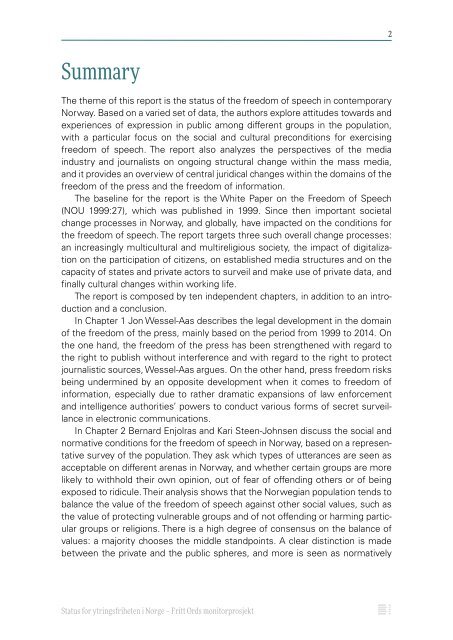Ytringsfrihet_Hovedrapport_DIG
Ytringsfrihet_Hovedrapport_DIG
Ytringsfrihet_Hovedrapport_DIG
You also want an ePaper? Increase the reach of your titles
YUMPU automatically turns print PDFs into web optimized ePapers that Google loves.
2<br />
Summary<br />
The theme of this report is the status of the freedom of speech in contemporary<br />
Norway. Based on a varied set of data, the authors explore attitudes towards and<br />
experiences of expression in public among different groups in the population,<br />
with a particular focus on the social and cultural preconditions for exercising<br />
freedom of speech. The report also analyzes the perspectives of the media<br />
industry and journalists on ongoing structural change within the mass media,<br />
and it provides an overview of central juridical changes within the domains of the<br />
freedom of the press and the freedom of information.<br />
The baseline for the report is the White Paper on the Freedom of Speech<br />
(NOU 1999:27), which was published in 1999. Since then important societal<br />
change processes in Norway, and globally, have impacted on the conditions for<br />
the freedom of speech. The report targets three such overall change processes:<br />
an increasingly multicultural and multireligious society, the impact of digitalization<br />
on the participation of citizens, on established media structures and on the<br />
capacity of states and private actors to surveil and make use of private data, and<br />
finally cultural changes within working life.<br />
The report is composed by ten independent chapters, in addition to an introduction<br />
and a conclusion.<br />
In Chapter 1 Jon Wessel-Aas describes the legal development in the domain<br />
of the freedom of the press, mainly based on the period from 1999 to 2014. On<br />
the one hand, the freedom of the press has been strengthened with regard to<br />
the right to publish without interference and with regard to the right to protect<br />
journalistic sources, Wessel-Aas argues. On the other hand, press freedom risks<br />
being undermined by an opposite development when it comes to freedom of<br />
information, especially due to rather dramatic expansions of law enforcement<br />
and intelligence authorities’ powers to conduct various forms of secret surveillance<br />
in electronic communications.<br />
In Chapter 2 Bernard Enjolras and Kari Steen-Johnsen discuss the social and<br />
normative conditions for the freedom of speech in Norway, based on a representative<br />
survey of the population. They ask which types of utterances are seen as<br />
acceptable on different arenas in Norway, and whether certain groups are more<br />
likely to withhold their own opinion, out of fear of offending others or of being<br />
exposed to ridicule. Their analysis shows that the Norwegian population tends to<br />
balance the value of the freedom of speech against other social values, such as<br />
the value of protecting vulnerable groups and of not offending or harming particular<br />
groups or religions. There is a high degree of consensus on the balance of<br />
values: a majority chooses the middle standpoints. A clear distinction is made<br />
between the private and the public spheres, and more is seen as normatively<br />
Status for ytringsfriheten i Norge – Fritt Ords monitorprosjekt


